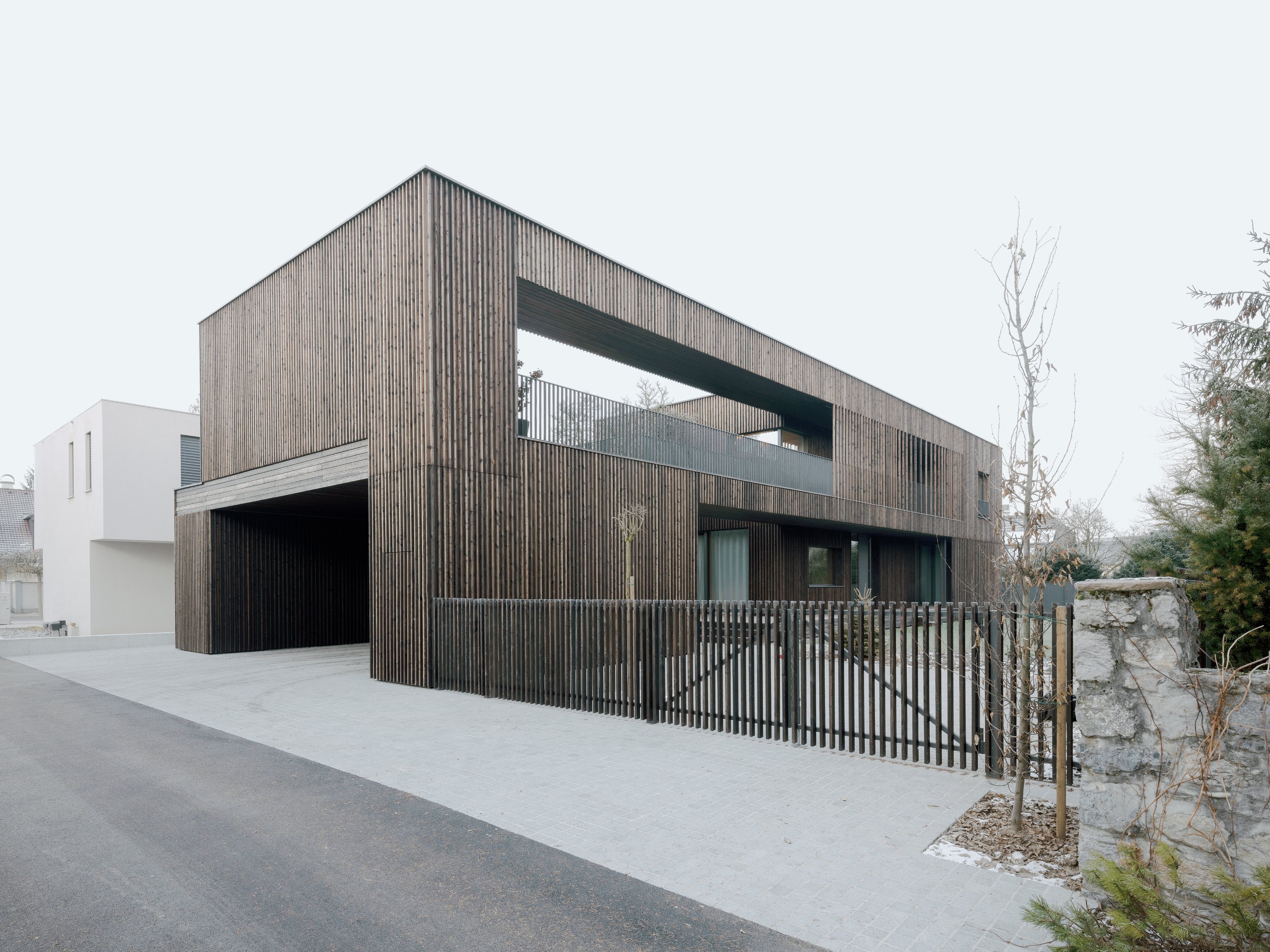Slovenian house creates a private world for its human and feline residents
OFIS Architects creates Catwalk House in Ljubljana, a Slovenian house in a serene timber clad box for a family and their pets

OFIS Architects has shaped a new Slovenian house in the Ljubljana suburbs for a family, with special attention paid to the needs of their pets. The 195 sq m structure consists of two timber-clad boxes, unified by vertical wooden cladding of varying density to allow light in and views out of the structure.

Catwalk: a new Slovenian house by OFIS Architects
The street frontage is defined by a double garage, above which is a courtyard garden, screened off from the road by the timber façade. A covered walkway leads back to the main house beyond, a simple two storey-structure with a kitchen diner at one end and a living room at the other, with two sides flanked by a terrace.

Upstairs, there are three bedrooms, as well as a bathroom, separate sauna and study. All bedrooms open on to the upper terrace, which links to the courtyard garden by a slender footbridge. This ‘catwalk’ was designed specifically to give the owners’ cats a private indoor/outdoor realm of their own without having to venture down onto the street.

With the catwalk doubling up as the cover from carport to entrance, the house is self-contained and enclosed, providing privacy in its suburban context with elements like the existing tree incorporated into the heart of the project. The 195m2 floorplan is carefully arranged to maximise the full length of the 30m plot, with storage and bike racks placed in the garage area and all services pushed to the edges of the plan on the ground floor, apart from a central utility core.

The architects used a pre-fabricated wooden building system for the main structure, using large panels of cross-laminated wood and a timber substructure to contain the insulation and facade cladding. Walls and ceilings are therefore made of factory-built 16cm thick panels containing insultation, with a mix of clay plaster and wood panelling as surface finishes. The wooden façade is clad in a layer of larch slats, with a charred finish that adds patina and enhances the weatherproofing.

Rok Oman and Špela Videcnik’s studio OFIS arhitekti was set up in 2000 after both had studied at the Ljubljana School of Architecture and London’s Architectural Association. The studio has won multiple nominations in the Mies van der Rohe Awards, among many other accolades, and has also exhibited in Paris, London and Venice.

Receive our daily digest of inspiration, escapism and design stories from around the world direct to your inbox.
Jonathan Bell has written for Wallpaper* magazine since 1999, covering everything from architecture and transport design to books, tech and graphic design. He is now the magazine’s Transport and Technology Editor. Jonathan has written and edited 15 books, including Concept Car Design, 21st Century House, and The New Modern House. He is also the host of Wallpaper’s first podcast.
-
 Modernism for sale: a Norman Jaffe-designed icon on Shelter Island hits the market
Modernism for sale: a Norman Jaffe-designed icon on Shelter Island hits the marketThe Osofsky House epitomised the glamour of high-end 70s modernism on Long Island. Now updated and refurbished, it’s back on the market for the first time in over two decades
-
 Discover Locus and its ‘eco-localism' - an alternative way of thinking about architecture
Discover Locus and its ‘eco-localism' - an alternative way of thinking about architectureLocus, an architecture firm in Mexico City, has a portfolio of projects which share an attitude rather than an obvious visual language
-
 MoMA celebrates African portraiture in a far-reaching exhibition
MoMA celebrates African portraiture in a far-reaching exhibitionIn 'Ideas of Africa: Portraiture and Political Imagination' at MoMA, New York, studies African creativity in photography in front of and behind the camera
-
 A new bungalow in Ljubljana is infused with the spirit of place
A new bungalow in Ljubljana is infused with the spirit of placeA bungalow set in the pioneering low-rise eco development of Murgle, the House under the Poplars trades grand architectural gestures for quiet innovation
-
 Boathouse Zaka is the radical renovation of an ageing structure into a light-filled workspace
Boathouse Zaka is the radical renovation of an ageing structure into a light-filled workspaceOFIS Architects turns a traditional boathouse into a lakeside laboratory on one of Slovenia’s best-loved bodies of water
-
 Studio Tim Fu announces the ‘world’s first fully AI-driven architectural project’
Studio Tim Fu announces the ‘world’s first fully AI-driven architectural project’The Zaha Hadid Architects alum has revealed the design for a collection of luxury villas on the shore of Lake Bled in Slovenia
-
 Frame House is a family home that appears carved from a solid block
Frame House is a family home that appears carved from a solid blockThis new home for a young family, Frame House makes the most of its suburban Ljubljana site with a design that offers covered play spaces, terraces and multifunctional rooms
-
 Ljubljana house is shaped by stepped terraces and simple forms
Ljubljana house is shaped by stepped terraces and simple formsOFIS Architects has created this Ljubljana house through careful sculptural geometries